An edited version of this article was published under the title “Handle with care” as a feature article in the UK “Bioenergy Insight” magazine, Volume 1, Issue 1, October 2010.
It’s fair to say that Europe is a decade ahead of the rest of the world when it comes to ‘green’ issues, and no more so than in the area of renewable energy sources, particularly utilizing woody biomass as a source of fuel.
Europe is an interesting case, as on one hand, it is the world leader on green issues and has vigorously promoted biomass as an alternative fuel; and on the other hand, it is far from sufficient sources of woody biomass.
As a contrast, Canada has a tremendous amount of woody biomass. And, for decades residual wastewood has been well-utilized as a fuel source for industrial plants. However, there is little incentive in Canada to utilize standing forests for fuel as we have such a small population, and an abundant supply of low-cost energy, for example, hydro power in BC, oil in Alberta, nuclear power in Ontario.
Likewise, Russia and the southeastern USA have large amounts of wood fibre available that can be used for energy production.
Biomass is not an easy material to handle. It appears in a myriad of species, forms and sizes; it knits together, doesn’t flow well, consolidates and 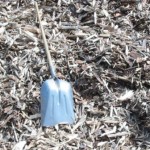 packs easily; it can have a wide range of moisture contents, basic and bulk densities and calorific values; it will freeze; it is very dusty, catches fire easily and is self-combustible; it can contain all manner of contaminants. Conversely, wood pellets are uniform in size and moisture content, are very free flowing, but are quite fragile and easily degrade and require special handling.
packs easily; it can have a wide range of moisture contents, basic and bulk densities and calorific values; it will freeze; it is very dusty, catches fire easily and is self-combustible; it can contain all manner of contaminants. Conversely, wood pellets are uniform in size and moisture content, are very free flowing, but are quite fragile and easily degrade and require special handling.
Currently, most of the wood pellets imported into Europe come from the province of British Columbia in Canada. Historically, most of the wood pellets have been manufactured from residual wastes from sawmills and other primary wood manufacturing plants. However, due to the collapse of the US housing market, lumber production has decreased significantly; and therefore, the amount of wastewood residuals available for pellets has decreased.
Compared to manufacturing wood pellets out of residual wastes, producing them from standing forests is significantly more costly as the process includes several more steps including logging, chipping and transportation. This increases the cost to the end-user.
The only way that wood pellet production is profitable is if the process is heavily subsidized by governments, which is what is happening in Europe. However, the wood pellet business is suffering right now due to: a) – high fibre costs; b)– a world-wide over-supply of pellets due to several new pellet plants starting-up; and c) – the economic crisis in Europe. Some of the new pellet plants in the USA have declared bankruptcy and have been shut down. In spite of this, the production and utilization of wood pellets is expected to increase in the next few years. Domestic use in the USA is also expected to increase due to that countries recent `green’ energy initiatives. And, in the province of Ontario in Canada, the provincial power authority, Ontario Power Generation (OPG), is considering converting three of its coal-fired power plants to biomass. This will put more pressure on the pellet supply and pricing.
As far as Europe is concerned, the challenge is getting the wood fibre from distant countries such as Canada, USA or Russia in a form that has the greatest value. The energy density of a fuel is prime consideration in reducing shipping costs, but that has to be weighed against the cost of producing the fuel. Suffice it to say that generally, the denser the fuel and the higher the btu’s per pound, the better the fuel.
Some companies are considering importing wood chips or hog fuel into Europe; this might prove economical from eastern Russia or from the Scandanavian countries, but most of the biomass being imported from overseas will likely be some form of pre-processed densified wood. Currently, the greatest amount of densified wood being imported into Europe is in the form of wood pellets. However, there is considerable interest in importing carbon pellets manufactured from torrified biomass. The torrefaction process has been utilized on a small scale for many decades, but it is now being improved and commercialized. Addtionally, bio-oils are being developed and may become a significant fuel source for Europe.
Wood pellets will likely continue to make up the greatest portion of woody biomass being imported into Europe, however, I believe that torrified wood pellets will soon become a significant portion. Consequently, I intend to limit my discussion here to the handling characteristics and requirements of these two materials.
Wood Pellets
Wood pellets are made from softwood or hardwood trees, which are logged, debarked, chipped, dried, conditioned, pelletized, and screened. The pellets are held together simply as a function of pressure and the lignin that is present in the wood. Currently, >90% of wood pellets are made to a premium quality with the following characteristics [i]:
- A minimum density of 642 kg/m³ (40 lb/ft³)
- Diameter: 6.4 – 8.0 mm (1/4” – 5/16”)
- Length: 38 mm (1 ½”) maximum
- Ash: <1.0% by weight
- Chlorides (salts):<300 ppm
Premium pellets are designed for domestic use in the home.
Industrial or standard grade pellets are made from wood and bark and they differ from the premium pellets only in the permissible ash content, which is <3% by weight. There is a trend in Europe to construct or convert large power boilers that will utilize standard grade pellets; hence, the amount of standard grade pellets imported into Europe will increase.
Wood pellets have the following handling characteristics:
- They flow well and if stored properly are not prone to bridging.
- They are fragile and easily break up when handled.
- The dust produced is very fine, combustible and explosive.
- They are quite dry at 12-15%, but absorb water readily, swell and fall apart.
Shipping and Unloading
Wood pellets tend to break up every time they are handled; they break up at every transfer point and even from rubbing together when being transported. When they break up, a very fine, talc-like dust is produced, which is difficult to contain and presents a significant fire and explosion risk. The more times pellets are handled the more they break up and the greater the fibre loss.
Current practices have pellets being handled many times between the manufacturing plant and the transport ship. Prospective importers should insist on the product being screened to remove the fines immediately prior to ship loading.
Most wood pellets are shipped in bulk form in 30 – 40,000 tonne ships. In order to avoid demurrage costs, these ships must be loaded and unloaded as quickly as possible; this requires that high capacity, material handling facilities be constructed at the loading and unloading ports. Care must be taken in the design of these systems to minimize pellet degradation. Utilizing existing coal unloading facilities makes considerable sense; however these need to be modified in order to handle pellets with the required care.
Ship Unloading
Pneumatic ship unloaders are particularly hard on wood pellets and should be avoided. Clamshell bucket unloaders or screw unloaders also cause pellet damage.
Wood pellets flow well and are conducive to being transported in self-unloading ships which utilize special-built holds with live-bottom belt feeders that discharge into a sandwich-belt type of ship unloader that elevates the pellets up and out of the ship.
Conveying Systems
All conveying systems that encourage impacts or rubbing, wedging or grinding actions should be avoided; including chain conveyors and screw conveyor feeder / extractors. The least damaging method of handling wood pellets is carrying them on belt conveyors; however, care must be taken to properly design the conveyor transfers to minimize the impact points. Additionally, care must be taken to protect the wood pellets from the weather.
Conveyors should be equipped with heat, smoke and flame sensors, sprinklers and fire suppression equipment.
Ideally, tubular belt conveyors that can accommodate both vertical and horizontal curves and therefore minimize the number of transfer points, would be used.
Storage and Reclaiming
Wood pellets must stored under cover and kept dry to minimize deterioration due to weather. Their good flowability allows the use of storage silos, but care must be taken in the design of silo loader and discharger. Pellets falling from a great height will be broken, therefore a spiral loading chute or a cascade loading chute is preferred.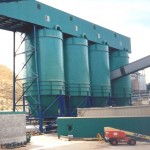
The action of mechanical dischargers underneath the load of a high silo can cause significant damage to pellets. However, pellets flow well, therefore silos can be designed without a mechanical discharger; but care must be taken with the design of the silo bottom.
A good silo discharging system would utilize a long belt feeder passing underneath the centerline of a line of silos. Each silo has a bottom that is sloped towards the center of the silo; multiple gates above the belt feeder can be sequentially opened to allow the pellets to flow through.
Smaller bins and hoppers that utilize dischargers such as a `Kamengo’ feeder or a `Keith Walking Floor’ have a gentle action that minimizes product damage.
Silos and hoppers should be equipped with deluge systems and rupture vents and dust suppression should be considered for open-topped hoppers.
Land Transportation
For long overland distances, train transport is usually more economical than that by truck. However, standard gondola cars that require emptying on a roll-over dumper should be avoided due to the pellet damage associated with the high material impacts. Bottom-discharge gondola cars are suitable.
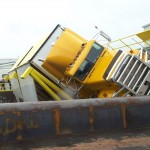 Transportation by bulk trucks is the most common method of moving pellets moderate distances. Several types and sizes of trucks are available and can be self-unloading or non-self unloading. Non-self unloading trucks need to be emptied on a side or end tipper. Care must be taken with the design of the tipper and receiving hopper to minimize the drop and subsequent material impacts and corresponding fibre loss.
Transportation by bulk trucks is the most common method of moving pellets moderate distances. Several types and sizes of trucks are available and can be self-unloading or non-self unloading. Non-self unloading trucks need to be emptied on a side or end tipper. Care must be taken with the design of the tipper and receiving hopper to minimize the drop and subsequent material impacts and corresponding fibre loss.
Self-unloading trucks that utilize pneumatic conveyors, chains and screws should be avoided in order to minimize product damage. Because pellets flow well, conventional bottom-discharging grain trucks can be utilized. Likewise, trucks with gentle `Walking Floors’ can also be used.
Screening / Metal Removal
Screens that impart vibratory or wedging and grinding actions should be avoided, as they will contribute to product degradation. Wood pellets are best screened on flat, gyratory screens such as that manufactured by `BM&M Screening Solutions’.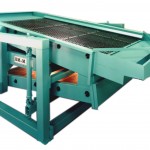
Generally, wood pellets are clean and have few contaminants when manufactured; however, after transportation from the manufacturing facility, shipping, unloading, land transportation, storage and reclaiming there is the possibility that metal has entered the product stream. Drum magnets and self-cleaning belt magnets are suitable for removing tramp ferrous metal from wood pellets. The best location for tramp metal removal is over a belt conveyor head pulley where the material is suspended in air.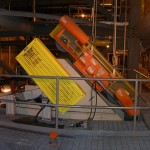
Dust Collection / Fire Protection
When handled, wood pellets produce a very fine dust that will hang in the air and travel long distances in a slight breeze. The dust is highly flammable and explosive, so all enclosures should be well ventilated and the ventilation air processed through a dust collector. Well designed and maintained dust collection systems utilizing baghouses are essential. High efficiency cyclones have difficulty separating the fine dust particles from the air stream and should be utilized only as a pre-separator, prior to a baghouse. Dust collection systems should be equipped with spark detection systems, deluge systems and abort gates. However, it is far better to design the handling systems to minimize the amount of dust generated.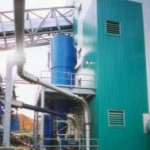
Crushing / Grinding
In some instances, consideration is being given to co-firing wood pellets with coal in existing coal-fired plants. To do so, necessitates that the wood pellets be reduced to a particle size similar to coal. Wood pellets easily break up and can be processed through high-capacity granulators. Some power companies are experimenting with processing wood pellets in coal pulverizers.
Alternative Pellet Transportation
Handling wood pellets in bulk form results in product degradation and fibre loss. Two alternative methods of handling wood pellets involve loading them at the manufacturing plant into either large bags or containers and transporting them to the end-user this way; the intent being to minimize handling and therefore product degradation.
However, the size of bag that can be handled is limited and bags are easily damaged. Standard 20’ shipping containers are ideal; they can be filled to capacity, whereas, 40’ containers cannot. Care must be taken to ship containers below decks to keep them dry.
Torrified Wood Pellets
Torrified pellets can be made from agricultural wastes or from woody biomass. The biomass is heated in a reactor at low temperature in the 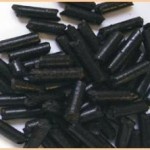 absence of oxygen. Torrefaction is a thermo-chemical process in which the hemi-cellulose decomposes producing various volatile gases and leaving a solid residue resembling coal. The gases can be converted to various chemicals and fuels. The solid residue is ground-up and pelletized.
absence of oxygen. Torrefaction is a thermo-chemical process in which the hemi-cellulose decomposes producing various volatile gases and leaving a solid residue resembling coal. The gases can be converted to various chemicals and fuels. The solid residue is ground-up and pelletized.
Most of the comments regarding wood pellet handling issues apply to handling torrified pellets; however there are some significant differences. Torrifed pellets have several advantages over wood pellets.
- They are approximately 30% more dense and their energy density is approximately 70% higher, which means lower transportation and storage costs.
- They are stable and don’t decompose, which means a lower fire hazard.
- They have a lower moisture content and will not easily absorb water and therefore can be stored outdoors.
- Their pellet strength is better and they don’t break up as easily when handled; meaning that losses and dusting issues are lower.
- They handle like coal and are better suited to processing through existing coal handling facilities.
Copywrite 2010
About the Author
Paul Janzé has more than 30 years experience in engineering design, project management, equipment manufacturing and maintenance, primarily in the forest products and energy industries. His material handling experience includes: biomass handling and processing including forest residuals, logs, lumber, chips, woodwaste, pellets, straw and poultry litter, animal tissue, sludge and biosolids; municipal solid waste (MSW); and coal and ash handling.
He has a keen interest in technologies which recover and utilize waste materials and convert them into products such as wood pellets. Paul’s specialties are fibre flow analysis and mass balances, process optimization and designing novel solutions to complex processing and handling problems.
Paul can be reached by email at: pjanze@telus.net

Any updates to the article?
hello
Dunnbrothersmachinery uk has developed a mobile 20/40 shipping container loader that can load biomass.
Hi Vance,
I am currently working on a project for Ontario Power Generation that is converting their coal-fired Atikokan generating station to 100% wood pellets. The project has been occupying all of my time, so I haven’t posted anything new for several months. However, I have started writing another article on the importance of spark, fire and explosion detection and suppression, which is extremely important when handling wood pellets. Hopefully, I will have this on my website by the end of the year.
Paul
We have to build a wood pellet facilitiy and we would like to know if there is any loading system for a wood pellet storage dome.
Hi Francisco,
First, thank you for visiting my website. I hope you found the articles on wood and biomass handling helpful.
And, yes, there are several different types of loading systems available for wood pellet storage domes. The type that is most appropriate for your facility depends upon:
– The type of storage dome and its ability (or not) to support external loads.
– The size of the dome.
– The conveying method to the dome that you are envisioning.
– The type of reclaim system you are envisioning, FIFO or LIFO.
I have many years of experience designing and constructing facilities for processing wood and biomass, the most recent being (2) 5,000 tonne wood pellet silos, and I am currently completing the design for a combination woodchip truck / railcar dumper.
I would be pleased to provide consulting services for your project. If you are interested, please provide more information about your company and your project so that I can tailor a proposal that meets your requirements.
Paul Janze
Hello, I have a question on the speed of a bucket elevator handling finish wood pellet product. What fpm recommendation would you have for the maximum on a bucket elevator?
Hi Tim,
Thank you for visiting my website.
The maximum speed of a bucket elevator depends upon the type of elevator. I am assuming that it is a belt type and not a chain type. But, is it a `continuous’ bucket elevator or a `centrifugal’ bucket elevator; the speeds are quite different. Do you currently have a bucket elevator and are you having capacity problems?
Send me the elevator design specifications, your required flow capacity and I should be able to tell you the required speed and maximum speed. A GA drawing would be helpful.
Paul
The following email string is between the website author and a university student that I have chosen not to identify. I thought the discussion may be of interest to others.
From: Raul ________
Sent: Saturday, January 23, 2016 11:10 AM
To: pjanze@telus.net
Subject: Wood pellets – Logistic costs
Dear Mr. Janzé
My name is Raul ________
I am student at _________ mexican university.
I have read your article “Handling Pellets – Things to Consider” and I would like to know the costs of loading and unloading wood pellets in truck.
Nowadays wood pellet are not trade in Mexico and there is poor information.
Do you have information about the costs?
I will be very grateful with your answer or your guidance
Best regards
Hi Raul,
Costs for loading and unloading wood pellet trucks can vary greatly and depend upon the local situation.
Loading Costs
The loading costs depend upon the loading method:
• Automatic dump from an overhead truck loading bin.
• Mobile front-end loader (FEL) directly into a truck.
• Direct from an on-board ship unloader.
• From a belt conveyor fed from a metering hopper, which is loaded by an FEL or by a ship unloader, or from a railcar.
Unloading Costs
The unloading costs depend upon the unloading method:
• Type and size of self-unloading truck: end or side tipping, or belly dump; live-bottom such as a `walking floor’ or belt, chain or screw conveyor, or integral pneumatic unloader.
• Type and size of non-self unloading truck requiring a truck tipper, receiving hopper and conveyor.
• Receiving hopper size affects the unloading time, which has a cost.
Other Costs to Consider
• Time required to load or unload.
• Electrical power costs for stationary equipment used.
• Mobile equipment costs, including fuel and maintenance.
• Operator labour costs.
• Equipment capital costs pro-rated over the through-put to get a unit cost.
• Demurrage on trucks, trains or ships. i.e. – wait-time cost for transporter while it is being loaded or unloaded.
• Administration costs.
If you define and address the above points, you should be able to calculate average costs per bone dry tonne ($/BDt), for loading and unloading wood pellets.
Paul Janze
Advanced Biomass Consulting Inc., Langley, BC, Canada
pjanze@telus.net
The following email string is between the website author and a client that I have chosen not to identify. I thought the discussion may be of interest to others.
From:
Sent: August 21, 2016 7:37 PM
To: pjanze@telus.net
Subject: Inquiry of Wood pellet silo
Dear Paul Janze mechanical engineer in engineering located in south Korea.
I am
Recently i design wood pellet handling system in Korea power plant.
I found your good web site from google search and learned a lot of knowledge from your website. Thank you.
I want to be advised from your knowledge.
Plant’s design data of wood pellet handling system is following :
1. Wood pellet condition
Diameter : 6-8mm
Length : <=32mm Density : >=600 kg/m3
Humidity : <=10% Durability : >=95%
2. Wood pellet silo
Capacity : 9,000ton
Size : ID 28m x Height 30m
Flat bottom type
Extraction type : Bottom rotating screw reclaimers
I consider which the material type of wood pellet silo is better with RC(Reinforced Concrete) or corrugated steel.
Can you advise me which material type silo is better?
Also silo is adopted spiral chute in a silo for preventing wood pellet to break up during fuel drop.
Can spiral chute is adopted same time at bottom rotating screw reclaimers?
If you know Atikokan generating station(GS) plant, i have one more question.
I ask this question because Atikokan GS is located in CANADA.
Can you explain why they applied explosion panels on top of RC silo? My opinion is that it’s for fire protection but I don’t know this explosion panel applied in steel silo.
I’m looking forward to your advice soon.
Best regards,
Response as follows:
From: Paul Janze [mailto:pjanze@telus.net]
Sent: Thursday, August 25, 2016 5:58 AM
To:
Subject: RE: Inquiry of Wood pellet silo
Hello,
Thank you for visiting my website.
In response to your questions:
Concrete or Steel Silos
1. Both steel and concrete silos are used for storing wood pellets. Which to use depends upon the forces imposed on the silo, the cost of raw materials, the availability of materials, the availability of skilled labour, etc.
2. The forces imposed upon a silo by the material being stored are phenomenal, and often dictate the choice of material for construction, particularly in high seismic areas. Forces to consider include:
• Dead load – the weight of the structure itself plus loads on top of the silo.
• Live load – the weight of the material inside the silo.
• Eccentric load – drawing down the material from one side.
• Dynamic load- movement of the material as it is filled and drained.
3. Also, you must consider wind loads and the seismic conditions.
4. The inside finish must be considered, particularly if you are designing for mass flow. Corrugated steel provides a surface that restricts flow down the inside surface, as does rough concrete.
Atikokan Plant
1. I see that you are somewhat familiar with the Atikokan GS wood pellet handling silos.
2. FYI, I did the conceptual and detail design for the EPC contractor that supplied the wood pellet handling system, so I am very familiar with the Atikokan project.
Explosion Panels
1. Wood pellets break-up at every transfer point and the very fine dust created is highly explosive. Methods of dust control and spark, fire and explosion prevention, detection and suppression are essential.
2. You mention explosion panels but they are only one part of the total asset protection system and are utilized to ventilate a possible explosion inside the silos, dust collectors, etc. Care must be taken with their design, selection and placement.
3. The potential fireball can be 8 x the volume of the container, so for a silo you need many explosion panels.
4. Explosion panels should be provided in either steel or concrete silos in order to prevent structural damage and to direct the fireball away from other structures.
Spiral / Helical Chute
1. Spiral / helical chutes were first used at Atikokan GS. I conceived the idea of using helical chutes to allow the pellets to slide to the bottom of the silos rather than falling >30m, thereby minimizing the impact forces and consequent breakage and small particle generation.
2. The detail design for a helical chute is quite sophisticated. There are many things to consider when designing a helical chute that will be buried inside the wood pellet mass.
• It must slow the material enough to be effective but must be self-cleaning.
• It must be strong enough to withstand the draw-down forces as the material mass drains around it.
• It must be strong enough to withstand eccentric loads.
3. It would be difficult to use a spiral / helical chute with a central, rotary screw discharger, as the helical chute is supported from the bottom, and by design, a rotary screw discharger covers the entire bottom of the silo.
4. I suppose the helical chute could be hung from the top of the silo, but that would require a massive overhead structure.
Silo Dischargers
1. Pellets are very free-flowing and will readily drain from openings in the bottom of silos into metering conveyor(s) underneath the silo. The pellet mass will drain down to a drain angle of ~36-42⁰ from horizontal. So, active dischargers are generally not required except for the very last remaining wedges of material left to the sides of the drain holes.
2. I don’t recommend the use of screw dischargers because of the very high shearing forces between the screw rim and the pellet mass that cause significant damage to the pellets.
3. If you are going to use a central screw type of discharger, I do recommend the use of the `Tube-feeder’, which is manufactured by Jeffrey-Rader. It damages the pellets much less and requires much less power to drive it.
4. A better discharger to use for the remaining wedges of material would be a vibrating floor that would move the pellets to the drain holes. See the Vibrafloor website.
5. A vibrating floor would also permit the use of a central spiral / helical feed chute.
Temperature Monitoring
1. A stored wood pellet mass will generate heat from biological degradation and oxidation; sufficient heat to self-ignite and smoulder. There are many examples of biomass silo fires started by self-heating.
2. Knowing and monitoring the temperature of the pellet mass is essential and provides the operator with early warning that temperature is increasing. Temperature monitoring must be coupled to the appropriate operating procedures in order to combat dangerous temperature increases.
3. Temperature monitoring is an integral part of the asset control system and is achieved by hanging multiple temperature cables down through the entire pellet mass inside the silo. These cables must be anchored at the bottom of the silos to keep them from `drifting’ laterally out to the sides of the silo and providing false readings.
4. Anchoring the temperature sensing cables to the silo bottom precludes the use of a central rotary screw discharger.
You can find the following articles on my website.
“Biomass Dust, Fire and Explosion Control”
http://www.advancedbiomass.com/2013/04/biomass-dust-fire-and-explosion-control/#more-307
“Helical Chute for Wood Pellets”
http://www.advancedbiomass.com/2014/11/helical-chute-for-wood-pellets/#more-405
“Handling Wood Pellets – Things to Consider”
http://www.advancedbiomass.com/2010/10/handling-pellets-things-to-consider/#more-118
My Experience Engineering for providing assistance with the design of your wood pellet handling system or any other wood and biomass handling system you may be considering. If this is of interest to you, please let me know.
I have considerable wood and biomass handling experience (>170 projects and studies in the past 30 years), primarily in the energy and pulp and paper industries. I do conceptual and detail design, prepare feasibility and definition studies, do high-level design reviews and undertake plant optimization and trouble-shooting assignments.
I would be pleased to submit a proposal to
Paul Janze
Advanced Biomass Consulting Inc.
Langley, BC, Canada
Tel: 1-604-505-5857
pjanze@telus.net
http://www.advancedbiomass.com
When transporting torrefied pellets, what type of trailer should be used?
Also,
What ports are the most ideal for shipping pellets?
Hi Paul
I am looking to start shipping pellets to Italy. I plan to use 40′ Open top shipping containers. However I have been told can’t fill to capacity but the 20′ containers you can. Why is this? What is the capacity a 40′ can hold? And is this the best container type for exporting overseas? Can’t fill a ship hold.
thanks.